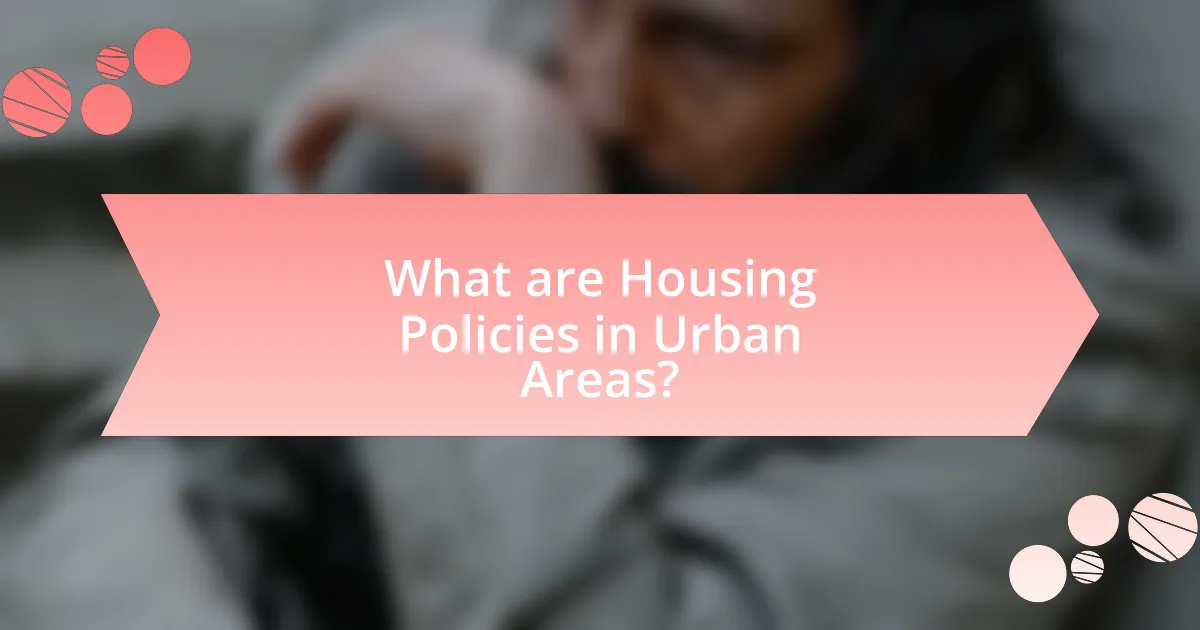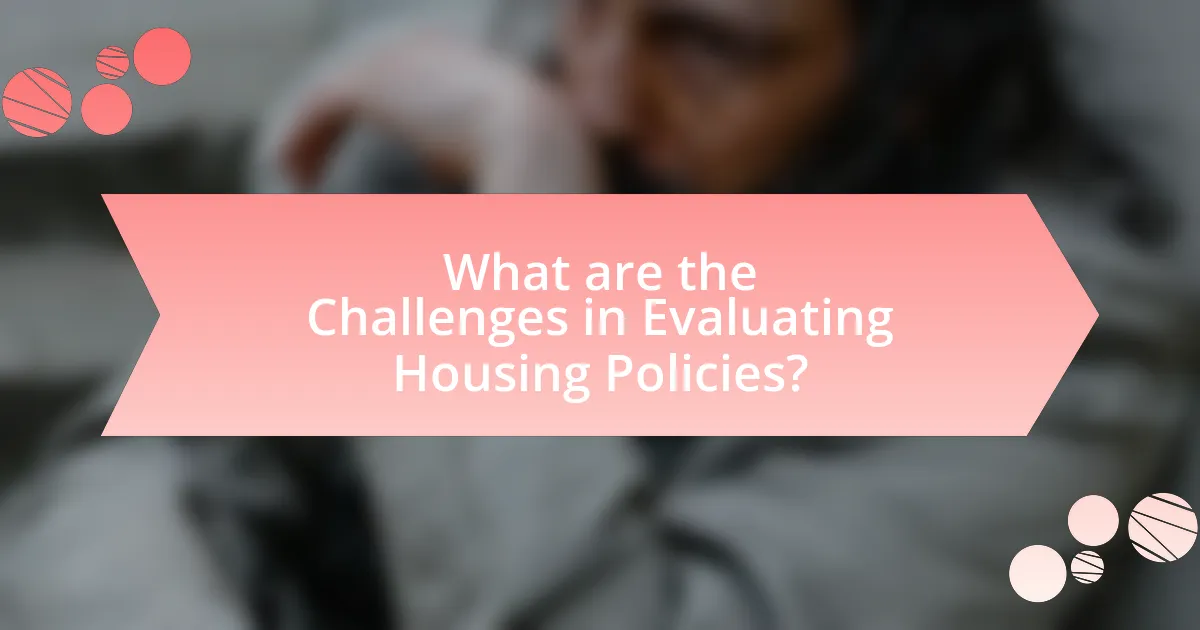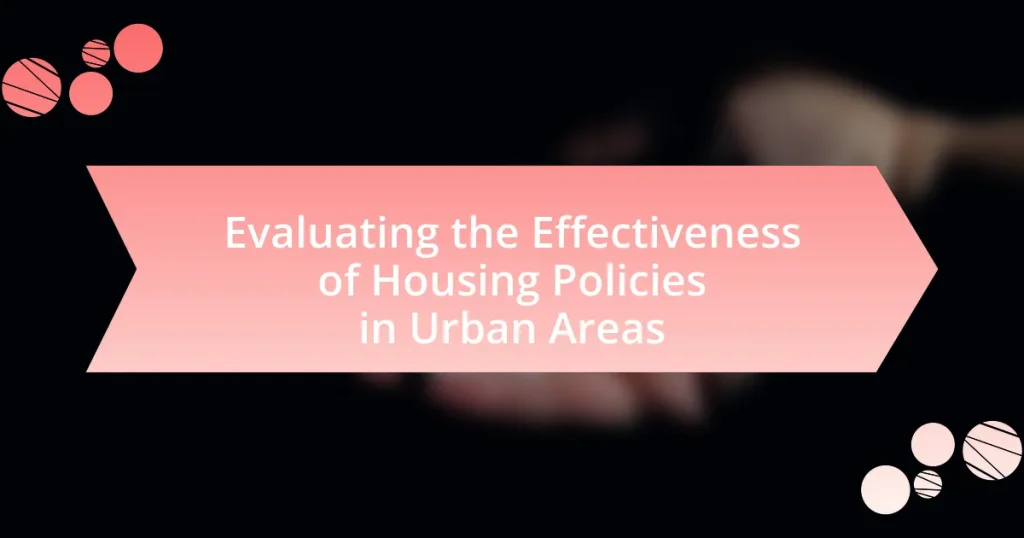Housing policies in urban areas are essential regulations and strategies implemented by governments to manage housing development, availability, and affordability. This article evaluates the effectiveness of these policies, focusing on their impact on urban development, affordability issues, and social equity. Key objectives include ensuring affordable housing, promoting sustainable growth, and addressing homelessness. The article also discusses the importance of evaluating housing policies through various metrics, the challenges faced in evaluations, and the influence of stakeholder perspectives. Additionally, it outlines methods for conducting evaluations, best practices, and the implications of findings for future housing policies.

What are Housing Policies in Urban Areas?
Housing policies in urban areas are regulations and strategies implemented by governments to manage and influence the development, availability, and affordability of housing. These policies aim to address issues such as housing shortages, homelessness, and urban sprawl, while promoting sustainable development and equitable access to housing. For instance, policies may include zoning laws, rent control measures, and incentives for affordable housing development, which are designed to ensure that diverse populations can access safe and affordable living conditions. The effectiveness of these policies can be evaluated through metrics such as housing affordability indices, rates of homelessness, and the availability of public housing units, which provide concrete evidence of their impact on urban communities.
How do housing policies impact urban development?
Housing policies significantly influence urban development by shaping land use, housing availability, and affordability. For instance, policies that promote affordable housing can lead to increased population density and economic diversity in urban areas. According to the Urban Institute, cities that implement inclusionary zoning policies see a rise in mixed-income neighborhoods, which fosters social integration and economic opportunities. Additionally, housing policies that incentivize development in underutilized areas can revitalize neighborhoods, attract businesses, and enhance public infrastructure. Thus, effective housing policies are crucial for sustainable urban growth and community well-being.
What are the key objectives of housing policies?
The key objectives of housing policies are to ensure affordable housing, promote social equity, and enhance urban development. Affordable housing aims to provide access to housing that is financially attainable for low- and moderate-income households, which is critical as studies show that over 30% of income spent on housing can lead to financial strain. Social equity focuses on reducing disparities in housing access among different demographic groups, ensuring that marginalized communities receive fair treatment in housing opportunities. Additionally, housing policies aim to enhance urban development by promoting sustainable growth, improving infrastructure, and fostering community development, which is supported by urban planning frameworks that emphasize mixed-use developments and transit-oriented designs.
How do housing policies address affordability issues?
Housing policies address affordability issues primarily through mechanisms such as rent control, subsidies, and the development of affordable housing units. Rent control limits the amount landlords can charge for rental properties, helping to keep housing costs manageable for low- and middle-income families. Subsidies, often provided by government programs, assist individuals in paying for housing by reducing their financial burden, thus making housing more accessible. Additionally, the development of affordable housing units increases the supply of lower-cost options in the market, which can help stabilize or reduce overall housing prices. For instance, a study by the Urban Institute found that cities with strong affordable housing policies saw a significant decrease in the percentage of cost-burdened households, demonstrating the effectiveness of these approaches in enhancing housing affordability.
Why is evaluating housing policies important?
Evaluating housing policies is important because it determines their effectiveness in addressing housing needs and issues within urban areas. Effective evaluation allows policymakers to assess whether housing policies achieve desired outcomes, such as affordability, accessibility, and sustainability. For instance, a study by the Urban Institute found that cities with robust evaluation frameworks for housing policies can better allocate resources and improve living conditions for residents. This evidence underscores the necessity of evaluation in ensuring that housing policies are responsive to the changing dynamics of urban populations.
What metrics are used to evaluate housing policy effectiveness?
Metrics used to evaluate housing policy effectiveness include affordability, housing quality, accessibility, and occupancy rates. Affordability is measured by the percentage of income spent on housing, with a common benchmark being that housing costs should not exceed 30% of a household’s income. Housing quality is assessed through indicators such as the presence of basic amenities, structural integrity, and safety standards. Accessibility metrics evaluate how easily different demographics can access housing, often considering factors like location relative to employment centers and public transportation. Occupancy rates indicate the demand for housing and can reflect the success of policies aimed at increasing housing supply. These metrics provide a comprehensive framework for assessing the impact of housing policies on urban populations.
How do stakeholder perspectives influence evaluations?
Stakeholder perspectives significantly influence evaluations by shaping the criteria and priorities used to assess housing policies. Different stakeholders, such as residents, policymakers, and developers, have unique interests and concerns that affect how they perceive the effectiveness of these policies. For instance, residents may prioritize affordability and accessibility, while developers might focus on profitability and regulatory ease. This divergence in priorities can lead to varying evaluations of the same policy, as evidenced by studies showing that community engagement in policy evaluation often results in more comprehensive assessments that reflect diverse needs (e.g., the research by the Urban Institute highlights the importance of stakeholder input in shaping effective housing strategies). Thus, stakeholder perspectives are crucial in determining the criteria for success and the overall evaluation outcomes of housing policies in urban areas.

What are the Challenges in Evaluating Housing Policies?
Evaluating housing policies presents several challenges, primarily due to the complexity of housing markets and the diverse factors influencing them. One significant challenge is the difficulty in isolating the effects of specific policies from other variables, such as economic conditions, demographic changes, and social factors. For instance, a study by the Urban Institute highlights that housing policy impacts can be confounded by broader economic trends, making it hard to attribute changes in housing outcomes directly to policy interventions. Additionally, data availability and quality pose challenges; comprehensive and reliable data on housing conditions, affordability, and demographic shifts are often lacking, which hampers effective evaluation. Furthermore, the varying objectives of housing policies—such as affordability, accessibility, and sustainability—create complications in measuring success, as different metrics may yield conflicting results. These challenges underscore the need for robust evaluation frameworks that can account for the multifaceted nature of housing issues.
What common obstacles do evaluators face?
Evaluators face several common obstacles, including data availability, stakeholder engagement, and methodological challenges. Data availability is often limited due to incomplete records or lack of access to relevant datasets, which hinders comprehensive analysis. Stakeholder engagement can be difficult as various parties may have conflicting interests or may be uncooperative, complicating the evaluation process. Methodological challenges arise from the complexity of housing policies and the need for robust evaluation frameworks, which can be resource-intensive and require specialized expertise. These obstacles can significantly impact the accuracy and effectiveness of evaluations in urban housing policy contexts.
How does data availability affect evaluations?
Data availability significantly impacts evaluations by determining the quality and comprehensiveness of the assessment outcomes. When data is readily accessible, evaluators can analyze various metrics, such as housing affordability, occupancy rates, and demographic changes, leading to more informed conclusions about policy effectiveness. Conversely, limited or poor-quality data can result in incomplete analyses, potentially skewing results and hindering the ability to make evidence-based recommendations. For instance, a study by the Urban Institute found that comprehensive data collection improved the accuracy of evaluations related to housing policy impacts, demonstrating that robust data availability is crucial for effective policy assessment.
What role does political context play in evaluations?
Political context significantly influences evaluations by shaping the criteria, priorities, and methodologies used in assessing housing policies. For instance, political agendas can determine which metrics are prioritized, such as affordability versus sustainability, thereby affecting the outcomes of evaluations. Research indicates that political ideologies impact policy implementation and evaluation processes, as seen in the differing approaches to housing policy in liberal versus conservative administrations. This context can lead to variations in funding, stakeholder engagement, and the overall effectiveness of housing initiatives, ultimately affecting the perceived success or failure of these policies.
How can biases affect the evaluation process?
Biases can significantly distort the evaluation process by influencing the interpretation of data and outcomes. For instance, confirmation bias may lead evaluators to favor information that supports their preconceived notions about housing policies, while neglecting contradictory evidence. Research indicates that evaluators’ personal beliefs and experiences can shape their assessments, resulting in skewed conclusions that do not accurately reflect the effectiveness of policies. A study by the Urban Institute found that evaluators’ biases can lead to misallocation of resources, ultimately affecting the implementation and success of housing initiatives.
What are the implications of biased evaluations on policy outcomes?
Biased evaluations can significantly distort policy outcomes by leading to misinformed decisions that do not accurately reflect the needs of the population. When evaluations are biased, they may favor certain groups or interests, resulting in policies that exacerbate inequalities rather than address them. For instance, a study by the Urban Institute found that biased assessments in housing policies often overlook the needs of marginalized communities, leading to inadequate support and resources for those most in need. This misalignment can perpetuate cycles of poverty and hinder overall urban development, ultimately undermining the effectiveness of housing policies designed to improve living conditions.

What Methods are Used to Evaluate Housing Policies?
Methods used to evaluate housing policies include quantitative analysis, qualitative assessments, case studies, and comparative evaluations. Quantitative analysis often employs statistical methods to assess the impact of policies on housing affordability, availability, and demographic changes, utilizing data from sources like census reports and housing surveys. Qualitative assessments involve interviews and focus groups to gather insights from residents and stakeholders about their experiences and perceptions of housing policies. Case studies provide in-depth examinations of specific housing initiatives, allowing for a detailed understanding of their effectiveness in particular contexts. Comparative evaluations analyze different housing policies across regions or time periods to identify best practices and outcomes. These methods collectively contribute to a comprehensive understanding of housing policy effectiveness in urban areas.
What qualitative methods are effective in evaluations?
Effective qualitative methods in evaluations include interviews, focus groups, and case studies. Interviews allow for in-depth exploration of individual perspectives, while focus groups facilitate discussion and interaction among participants, revealing collective insights. Case studies provide comprehensive examinations of specific instances, offering contextual understanding of housing policies in urban areas. These methods are supported by research indicating that qualitative approaches yield rich, nuanced data that quantitative methods may overlook, thus enhancing the evaluation of housing policy effectiveness.
How do interviews and focus groups contribute to understanding policy impact?
Interviews and focus groups provide qualitative insights that enhance the understanding of policy impact by capturing the perspectives and experiences of stakeholders directly affected by housing policies. These methods allow researchers to gather nuanced information about how policies are perceived, implemented, and experienced in real-life contexts. For instance, interviews with residents can reveal specific challenges they face, such as affordability or accessibility issues, which quantitative data might overlook. Focus groups facilitate discussions among diverse participants, highlighting common themes and differing viewpoints that can inform policymakers about the effectiveness and areas for improvement in housing initiatives. This qualitative data complements quantitative evaluations, providing a more comprehensive view of policy outcomes and their implications for urban housing strategies.
What case studies provide insights into housing policy effectiveness?
Case studies that provide insights into housing policy effectiveness include the “Moving to Opportunity” experiment in the United States, which demonstrated that providing housing vouchers to low-income families led to improved educational and economic outcomes for children. Additionally, the “London Housing Strategy” case study highlights how policies aimed at increasing affordable housing supply have resulted in a measurable decrease in homelessness rates. Furthermore, the “Vienna Model” showcases how a strong public housing sector can maintain affordability and quality, contributing to overall urban stability. These case studies illustrate the impact of targeted housing policies on social and economic outcomes in urban areas.
What quantitative methods are commonly employed?
Commonly employed quantitative methods in evaluating the effectiveness of housing policies in urban areas include regression analysis, surveys, and statistical modeling. Regression analysis allows researchers to identify relationships between variables, such as housing prices and policy changes, providing insights into the impact of specific policies. Surveys collect data from residents regarding their experiences and perceptions of housing policies, enabling statistical analysis of trends and outcomes. Statistical modeling, including techniques like time series analysis, helps in forecasting the effects of policies over time, allowing for a comprehensive evaluation of their effectiveness. These methods are widely recognized for their ability to provide empirical evidence and support data-driven decision-making in urban housing policy assessments.
How do surveys measure public satisfaction with housing policies?
Surveys measure public satisfaction with housing policies by collecting quantitative and qualitative data from residents regarding their experiences and perceptions. These surveys typically include questions about affordability, availability, quality of housing, and the effectiveness of local housing initiatives. For instance, a survey might ask respondents to rate their satisfaction on a scale from 1 to 5, providing measurable insights into public sentiment. Additionally, open-ended questions allow for detailed feedback, which can highlight specific concerns or suggestions. Research indicates that surveys can effectively capture trends in public opinion, as seen in studies conducted by the Urban Institute, which found that 70% of respondents expressed dissatisfaction with current housing policies in urban areas.
What statistical analyses are used to assess policy outcomes?
Statistical analyses used to assess policy outcomes include regression analysis, propensity score matching, and difference-in-differences. Regression analysis helps determine the relationship between policy implementation and outcomes by controlling for confounding variables. Propensity score matching allows researchers to compare treated and untreated groups with similar characteristics, thereby isolating the effect of the policy. Difference-in-differences compares outcomes before and after policy implementation across different groups, providing insights into the causal impact of the policy. These methods are widely recognized in empirical research for their effectiveness in evaluating policy impacts.
What are the best practices for conducting evaluations?
The best practices for conducting evaluations include defining clear objectives, utilizing appropriate methodologies, engaging stakeholders, and ensuring data integrity. Clear objectives guide the evaluation process, allowing evaluators to focus on specific outcomes related to housing policies. Employing methodologies such as mixed methods or case studies enhances the depth and breadth of the evaluation, providing comprehensive insights. Engaging stakeholders, including community members and policymakers, fosters transparency and relevance, ensuring that the evaluation addresses the needs of those affected by housing policies. Lastly, maintaining data integrity through rigorous data collection and analysis methods ensures the reliability of findings, which is crucial for informing policy decisions. These practices are supported by research indicating that structured evaluations lead to more effective policy implementation and improved housing outcomes.
How can evaluators ensure objectivity in their assessments?
Evaluators can ensure objectivity in their assessments by employing standardized evaluation criteria and methodologies. Standardized criteria minimize personal biases and provide a consistent framework for assessment, allowing evaluators to focus on measurable outcomes rather than subjective opinions. Research indicates that using objective metrics, such as quantitative data on housing affordability and accessibility, enhances the reliability of evaluations. For instance, a study by the Urban Institute highlights that assessments based on clear, predefined indicators lead to more accurate evaluations of housing policies.
What strategies enhance stakeholder engagement during evaluations?
Strategies that enhance stakeholder engagement during evaluations include fostering open communication, involving stakeholders in the evaluation design, and providing regular updates on evaluation progress. Open communication allows stakeholders to express their concerns and expectations, which can lead to more relevant evaluation outcomes. Involving stakeholders in the evaluation design ensures that their perspectives and needs are considered, increasing their investment in the process. Regular updates keep stakeholders informed and engaged, reinforcing their role in the evaluation and encouraging ongoing participation. Research indicates that these strategies lead to higher satisfaction and better utilization of evaluation findings, as evidenced by a study published in the American Journal of Evaluation, which found that stakeholder involvement significantly improves the relevance and impact of evaluations.
What are the implications of evaluation findings for future housing policies?
Evaluation findings significantly influence future housing policies by identifying successful strategies and areas needing improvement. For instance, data from housing policy evaluations often reveal the effectiveness of specific interventions, such as affordable housing initiatives or zoning reforms, in addressing urban housing shortages. These insights guide policymakers in allocating resources more efficiently and designing targeted programs that meet the needs of diverse populations. Furthermore, evaluations can highlight unintended consequences of existing policies, prompting necessary adjustments to enhance their effectiveness. For example, a study may show that certain housing policies inadvertently increase displacement, leading to a reevaluation of those strategies to prioritize community stability. Thus, the implications of evaluation findings are crucial for shaping responsive and effective housing policies that adapt to changing urban dynamics.
